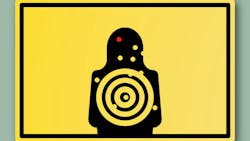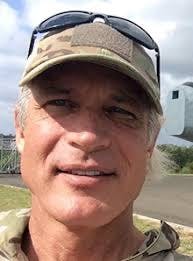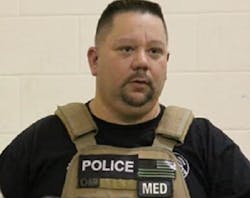Learning the Hard Way: Keeping Use-of-Force Training Safe
Practice like you want to play the game. It’s an adage that’s popular at almost all levels of athletics, and it’s an ethos embraced by L.E. But with a profession that can involve perilous or fatal situations, how do you create training drills that are as realistic as possible, especially in use-of-force scenarios? Even with safety protocols, reaching that level of authenticity can have dangerous consequences.
This article appeared in the January/February issue of OFFICER Magazine. Click Here to view the digital edition. Click Here to subscribe to OFFICER Magazine.
Late last year, there were at least three acci dental law enforcement training shootings:
- August: A Washington, D.C., officer was killed when she was shot by an instructor during a training session at a library.
- October: A veteran U.S. Customs and Border Protection officer was fatally shot by a colleague in an exercise at an outdoor Miami gun range.
- December: A Sansom Park, Texas, police officer was critically wounded when she was shot in the face during an active shooter training exercise at a school.
OFFICER Magazine spoke with two training instructors about the measures taken to ensure that drills are safe.
‘No substitute for experience’
Good law enforcement training tries to create drills that bring participants as close as possible to what they’ll face on duty. And when it comes to training for situations that could involve a physical confrontation, the more realistic the setting and scenarios, the better.
“There’s no substitute for experience and giving people pseudo-experience and the highest fidelity possible will actually create pre-combat veterans,” says Ken Murray, the training director for the Armiger Police Training Institute in Florida and founder of the Reality Based Training Association. “We’ve been able to prove this time and again. And also when it’s done properly and effectively, we were able to demonstrate through some studies with the Australian Special Forces that you’ll get a 600-800% increase in training efficacy with longer durability over shorter periods.”
A master instructor who has spent years as a police and mili tary trainer, Murray has written a book and multiple articles and policy papers on the topic. In the late 1980s, he co-founded the non-lethal ammunition and training company Simunition.The training isn’t just about picking up the physical skills needed to respond to a variety of potentially dan gerous calls and events. It’s also about acquiring mental and emotional discipline in the face of intense situations, something Spotsylvania County, Virginia, Deputy Sheriff Tom Perroni calls “stress inoculation.”
Perroni, along with being a deputy, is the current owner and training director for the Commonwealth Criminal Justice Academy in Virginia. He’s worked in public safety and law enforcement for over 30 years and an instructor for just as many, with 15 of those years as a firearms instructor.
“I think force-on-force training is very important,” he says. “It’s probably the closest thing we can get to realism as far as understanding it’s the actual weight of your gun, when you pull the trigger you get a bang, a projectile comes out, and you’re firing a projectile at a human being. … It’s a dynamic situation that’s evolving, and you have to think, shoot, move and communicate, and it adds a realism that’s unmatched in training.”
But realistic training has its limits. To para phrase Allen Iverson, we’re talking practice.
“When you say force, there is some mea sure of physicality,” says Murray. “I will say there’s some measure of interactivity, but not necessarily a use of force.”It’s when that physicality and interactivity come into play that safety becomes essential.
Following the protocols
If training is the foundation of a good law enforcement officer, then preparation and forethought are the building blocks of a good training. That starts with by answering a seemingly basic and self-evident question: Why are we doing this training?
“The first thing is we decide what are we testing and we should be teaching them before we test,” says Murray.
“What most experiential training ends up being is experimental training, in that they don’t truly know what the outcome is going to be,” he adds. “They’re going to put something into motion, stand back with their clipboard, watch what happens, and then give them the positive-negative-positive sandwich, which is one of the silliest ways to train that I’ve ever seen.”
Murray says not having clear training goals can set off a ripple effect that can have ramifications when it comes to the actual exercises. A “let’s see what happens” approach can lead to loosely scripted and mapped out scenarios that can leave too much up to chance. A lack of tight planning creates a less-controlled environment and potentially increases the possibility of potentially dangerous accidents.
Once goals are established and plans are in place, work begins to make sure the training area and drill itself are safe. Murray and Perroni both religiously run through safety checklists before every exercise begins. Perroni, in fact, has his checklists on flip cards that he likens to an officer’s Miranda rights card.
“We’ve got an entire protocol that we go through in our schools that we train for instructors, and we’ve got a checklist that takes you all the way through how to make an area safe,” says Murray. “We break things down by areas much like the FAA breaks down airspace. Class A airspace … is the most controlled airspace there is. That’s where jumbo jets are flying. That’s where everything big and fast is floating around with a lot of people on board. And so with us Class A space is the most dangerous, as well, because we’re doing interactive training and we’re going to be pointing weapons at each other. We’ve got different levels of weapons that we’re going to be pointing at each other and we break those down by conditions. By way of example, condition blue is anything that can fire a pro jectile at you. That can either be a marking cartridge, a paintball or an Airsoft VB.”The instructors also heavily rely on their dedicated safety officers. These are the people in blaze orange vests who stay vigilant that the safety rules are being followed. That can mean securing a training environment searching and re-searching participants to make sure they aren’t bringing unsanctioned equipment, such as their ser vice weapons, into the area. And in the reverse, it can mean double-checking to see that everyone is wearing all of the proper protective gear. Murray says it’s not unusual for participants—and even agencies—to be lax in enforcing the safety protection, thinking that it’s not a big deal in much the same way a motorist might not buckle up.
“There’s got to be some manner of personal protective equipment and that’s non-negotiable if we’re going to be shooting things at each other,” he says. “And a lot of agencies dumb that down to the point they allow groin protection not to be worn. They allow gloves not to be worn. They allow throat protection not to be worn. Some agencies are as idiotic as to only allow eye protection instead of face protection. And these are some pretty large, sophisticated agencies that do things catastrophically badly. And they’re just they’re going to run out the clock and create either significant injury or potential death.
“Now, with the significant injury part of things, every single one of them is avoidable.”
But not-so-significant injuries are no walk in the park either. Ask Perroni, who was mistakenly shot with a non-lethal round while he was running a room clearing exercise for civilians. He was the safety officer for the drill and was outfitted in his protective gear and an orange vest.
“We had one young man who was very excited,” says Perroni. “He had been excited for weeks leading up to this class, and he was probably the fourth person to make a run through the house. I was standing at the end of the hallway observing him while he was moving with an instructor … and he saw me, and he shot me more than once. Probably put five or six rounds in me.
“And so that was a learning lesson to everyone. Just because you have a gun in your hand doesn’t mean that everyone is a bad guy and that you have to shoot them,” he adds. “He was so keyed up and had such tunnel vision that he just saw somebody and he started pulling the trigger.”
Leading by example
When it comes to preventing gaps in safety protocols, Murray points to being alert for pattern disruptions, which are actions and events that can interrupt your normal habits and potentially introduce dangerous situations. He likens it to a mother placing a baby carrier on top of a car and then answering a phone call. She might have a conversation and by the time she’s done, she’s forgotten about the child on the roof and is driving away.
“Pattern disruptions happen to us all the time, and when we get pattern disrupted, when the interruption goes away, we will go back into the part of what we were doing before, and it might not be safe to do so,” he says.
Murray also stresses that instructors need to remember just how important and influential they are to the officers they train. Instructors not only reinforce the proper safety standards needed in a training environment, but the professional standards needed on the job.
“When I was seeing stage hypnosis 40 years ago, I thought, that can’t possibly be real, and if it is, it horrifies me as a trainer because if people are that malleable at some stranger can look them in the eye, say three magic words, and have them believe that they can’t remember their own name on purpose, then what are we doing by accident?” says Murray, who eventually became a hypnotist himself. “Because every trainer in his own right as a hypnotist, they’ve got all of the makings of a hypnotist. They have prestige, they have someone’s undivided attention, and they have, by its very nature, a co-opting of their critical faculty. And so anything that goes in, we need to be really, really cautious about what gets in there above and beyond the pure physical dangers of a realistic training environment.”
That’s a message that Perroni echoes, as well. Leading by example can be one of the best ways to ensure a safe training experience.
“I don’t think anyone would purposely cause harm, but we’re not perfect, nobody’s perfect,” he says. “We all mistakes, and we have to double-check, triple-check and verify that we’re safe in all training environments, all the time. The safety rules are there for a reason.
To contact Ken Murray, email him at [email protected].
This article appeared in the January/February issue of OFFICER Magazine.
Top 10 Training Safety Red Flags
Law enforcement training participants should always feel like they can call a “time out” if they feel an exercise isn’t safe, says instructor Ken Murray. But what should they be looking for? Murray outlines 10 things that should give officers serious pause. “These are the liner notes, not the album. But I will look for these things if I enter a training environment.”
- Haphazard or nonexistent safety standards and protocols.
- Lack of written safety protocols: “Because if they’re not reading any of this stuff from a checklist or off a written briefing, if they’re just making (it) up as they go along, giant red flag for me.”
- Anytime the word or phrase “big boy rules” is used: “I will immediately ask, ‘Well, what does that mean, and why should we be following them?’ I would much rather follow some written and solid best practices safety guidelines.”
- Unsafe or uncontrolled training environments.
- BYOS or Bring Your Own S***: “Anytime agencies say, yeah, just bring your own stuff, and we’ll allow that to be used in the scenarios. …yeah, no.”
- Unscripted or loosely scripted role players.
- Sketchy trainer credentials.
- Mixture of conventional and nonconventional munitions and use.
- Instructor hubris: “That’s just anybody who thinks he’s too cool for school. That’s one of my big red flags.”
- Participants armed with conventional weapons inside a controlled environment: “If you think that you’re exempt from the safety rules, you are wrong.”






